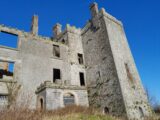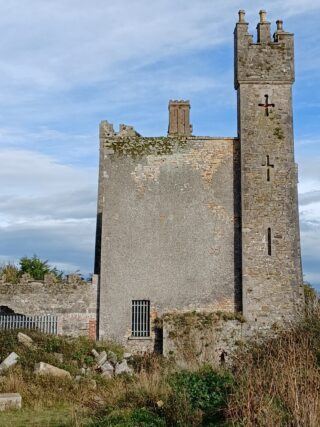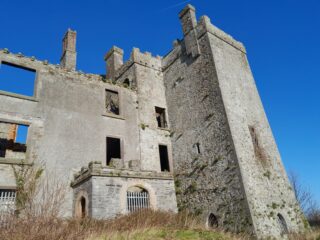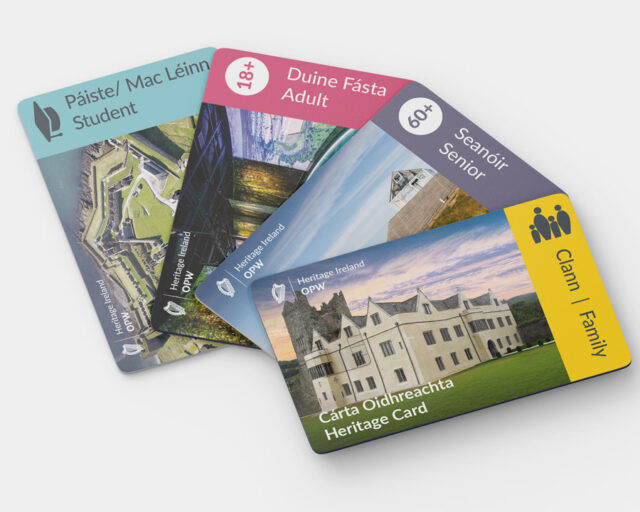Notice
Athcarne Castle is a state-owned National Monument in the care of the Office of Public Works
*No Public Access*
WARNING: It should be noted that these sites are unguided and a level of care and caution should be maintained during all stages of your visit. The Office Of Public Works (OPW) will not be held responsible for any damages, injuries, or losses that occur
Athcarne Castle
Lying on a north-east to south-west axis, the sombre and ruined remains of Athcarne Castle sit on the western bank of the Hurley River. The original estate is bounded to the north by the Nanny Water and is situated in the 321 acre townland of Athcarne, 4.8 km (3 miles) south west of the centre of the small Co. Meath town of Duleek. The castle sits in a farmer’s field at the end of a muddy track and of a narrow road that leads from the Abbey Road (L1610), which connects the village of Ballymagarvey to the west and Duleek to the east.
The Irish place name of Áth Cairn means the Fording Point at the Cairn or burial mound. It has been suggested by historians that the castle was built on or near a cairn and the Ordnance Survey map of the 1830s shows that opposite it, on the eastern bank of the Hurley River and in the townland of Boolies Great, is an ancient motte.
According to 'The Baronetage of England' by John Debrett, the De Bathe family was "of great antiquity, having come into England in AD1066 with William the Conqueror, from Normandy, of which country was Hugo de Bathe, who accompanied Earl Strongbow, in his expedition to Ireland, in 1172, and had grants of Manors and Lands in the counties of Dublin, Meath, Louth, and Drogheda.
Mathew de Bathe, the descendant of Hugo, was granted by Edward the Third the manor of Rathfeigh in Co. Meath, which is located 13 km (8 miles) south of the village of Slane. He also obtained the custody of the King's Manor of Leixlip. Mathew died in 1350, and was eventually succeeded in his properties by his descendant John de Bathe, who had become Chief Magistrate of Dublin. His son James was Chief Baron of the Irish Exchequer in 1547. James de Bathe died in 1570 and was succeeded by John, the Chancellor of the Exchequer, who died in 1586. James and John were the grandfather and father, respectively, of the musicologist and member of the Jesuit order William Bathe, S.J. (1564-1614).
John Bathe of Athcarne was appointed Recorder of Drogheda in 1545 and later held the office of Solicitor General in Ireland and Justice of the Common Bench, and William Bathe, the builder of Athcarne, was Second Justice of the Common Pleas and died in 1599, though without leaving issue. The de Bathe family thus played a longstanding role in Irish civil and legal life for over 400 years.
A memorial tablet was placed in the bridge in Duleek, its words revealing that the river crossing was erected by "William Bathe of Athcarne, justice, and Jennet Dowdall his wife in the year of our lord 1587." Carved into this tablet, as recorded by the artist George Victor Du Noyer, are the initials W.B. and J.D., below which are the couple’s heraldic coats-of-arms. Embedded in one of the outside walls of Athcarne Castle are two matching carved granite coats-of-arms displaying the date of 1589.
In Duleek village, a wayside cross bears the following inscription: "This cross was builded by Genet Dowdall, wife of William Bathe, Justice of Her Majesty’s Court of Common Plees, for him and her, anno 1601. He deceased the 15th of Oct 1599, is buried in the Church of Duleek, whose souls I pray to God take to his mercie." The spellings read as they are incised.
At Ardcarne, on the roadside outside the entrance to the neighbouring 18th century Annesbrook House, is another wayside cross that reads (as spelled): "This cross was builded by Jennet Dowdall, late wife unto William Bathe, of Ardcarne, Justice, for him and her, in the year of our Lorde Amen. I.H.S." It was declared a National Monument in 1935:
https://heritageireland.ie/unguided-sites/athcarne-white-cross
A third cross is located in the townland of Reask, near Duleek. In his 'The Crucifixion in Irish Art: Forty Examples from the Ninth to the Twentieth Century" the late historian Peter Harbison says of it: "One of the few pieces of real sculpture, as opposed to just stone-carving, found among the crucifixions of the seventeenth century is that on the wayside cross at Athcarne, County Meath, known as the White Cross.”
Above several doorways at Athcarne Castle, carvings record that the castle was erected in 1590 by the above-mentioned Sir William Bathe and his wife Jennet. On Sir William's death in 1599, Athcarne was occupied by his brother James Bathe and subsequently by James' heirs. About the year 1700, the de Bathe family departed for good from the property, after which if came into the possession of the family of Henry Garnett and his wife Alicia Cope of Dublin.
In the 5th January 1833 issue of the Dublin Penny Journal, an illustrated article described Athcarne Castle as “one of the most interesting in several particulars” and noted that “it preserved, until lately, without change, its original form and character, a peculiarity which bad taste and love of change has rarely permitted our ancient buildings of this class to retain.” The article also recorded the various generations of the de Bathe family who had held possession of the property during the 17th century.
Around 1830, Athcarne was bought by the Gernon family who significantly remodelled it. The original tower house was left in place but the family demolished Sir William de Bathe’s 1590 Elizabethan mansion house and built a more modern extension with larger windows, as was the fashion at the time. The frontage orientation was changed to a south-facing direction and, by creating a dam in the river Hurley every winter, a boating lake was built at the front of the castle. The accompanying illustration to the Dublin Penny Journal article showed the castle as it was prior to the Gernon family’s alterations. The construction of the existing, though severely dilapidated, house dates to the short reign of William IV, which began in 1830 at the end of the Regency period, and lasted until 1837, the start of the Victorian era.
According to Samuel Lewis’ 1837 survey, Athcarne Castle was the "the seat of J. Gernon Esq.", that it had previously belonged to the Bathe family and that it was "a perfect specimen of the Elizabethan castellated style". Lewis goes on to say that "it is a massive pile of building, with a still more massive keep defended by quadrangular embattled towers, and the whole was formerly surrounded by a fosse: the present proprietor has made some additions and improvements.”
Following a downturn in their fortunes the Gernon family sold the castle at auction in 1939. Following its sale, the building was stripped of its distinguishing architectural features, which were sold off for building salvage. Suggestions were made that the fabric of the castle should be robbed out to be used as filling material for the building of local roads but these were never acted upon. The castle passed into the care of the Office of Public Works.
Today, Athcarne Castle stands in precarious structural condition and extreme caution is advised if permission is being sought to visit it.
Visit Historic Environment Viewer for more information on Athcarne Castle
Protect our Past - Click here to read about the importance of protecting our country’s unique heritage sites
This national monument is protected in accordance with the National Monuments Acts 1930 to 2014
Gallery
Nearby sites to visit
Brú na Bóinne Visitor Centre: Newgrange, Knowth and Dowth
Step into Ireland’s richest archaeological landscape
Approx. 8.0 km from Athcarne Castle
Battle of the Boyne Visitor Centre – Oldbridge Estate
Where two kings fought for Europe’s future
Approx. 11.3 km from Athcarne Castle
Hill of Tara
Experience the legacy of the high kings
Approx. 12.2 km from Athcarne Castle



